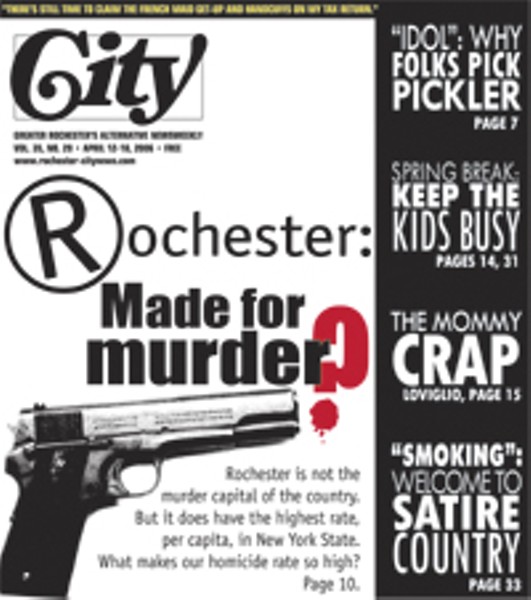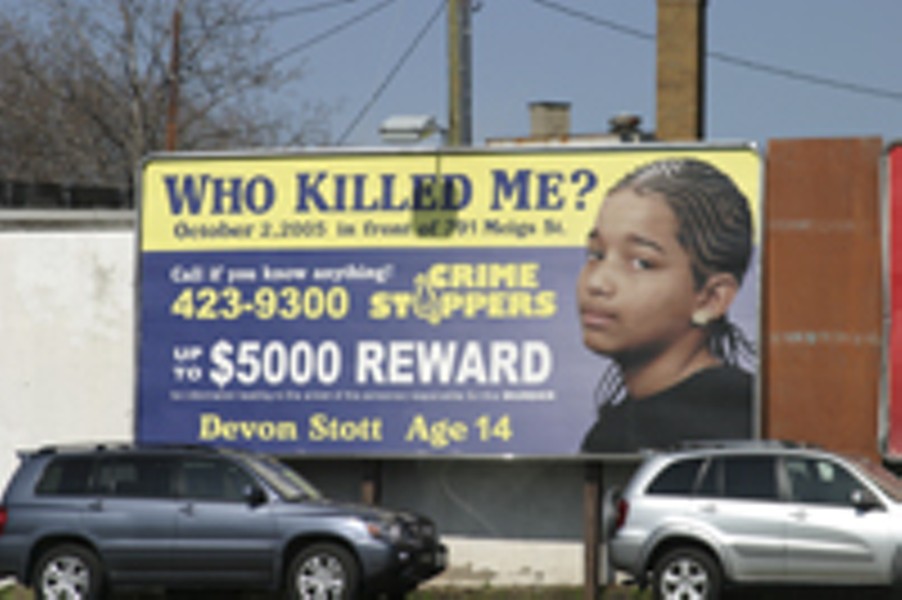First of an occasional series.
Last week, a grand jury indicted three Rochester men in connection with the March 9 murder of Herschel Scriven, a young minister and church organist, in southwest Rochester.
The night before the Scriven indictments, two men were shot in northeast Rochester. On Sunday morning, two others were shot in the same area of the city, and a third was fired at as he drove his car. None of those shootings were fatal, but the repetition underscores the severity of Rochester's violent-crime problem.
And summer is still two months away.
This is the state of affairs Chief David Moore inherited when he took the helm of the city's police department on Monday.
We all know the stories. And we know the demographics --- of murderers and victims. They are young, they are male, and they are black. One of the men indicted in the Herschel Scriven murder is 20 years old. The other two are 19. Scriven was 23. All are African Americans.
Rochester is not the murder capital of the country. But it does have the highest rate, per capita, in New YorkState. Among the 40 cities with populations between 180,000 and 250,000, says RIT criminologist John Klofas, Rochester's probably in the top four in homicides. And, says Klofas, "if you look at New YorkState, Rochester is almost always the leading city for homicides."
Last year, Rochester's murder rate was about 25 per 100,000 people, says Klofas. New York City's rate: less than 6 per 100,000.
Klofas cautions that crime statistics are tricky. The national homicide rate, for instance, is about 6 per 100,000, but the national figures combine cities, suburbs, and rural areas. Even with New York City, "you've got to be careful making these kinds of comparisons," says Klofas, because it includes wealthy neighborhoods, poor neighborhoods, suburbanized neighborhoods.
Still, such statistics are useful "to get a handle on where we stand overall," he says. "If you look at any 10-year period, we average somewhere around 50 homicides a year here, which is high."
Klofas, who is a professor of criminal justice at RIT, has been studying crime in Rochester for nearly 20 years, and his research has included numerous interviews with convicted murderers and victims' families. A frequent consultant to the region's criminal-justice system, as well as in other American cities, he co-chaired the public-safety steering committee of Mayor Bob Duffy's transition team.
While the popular perception is that the city's murder rate is driven by drug use and drug sales, Klofas sees deeper, more complicated roots. And they begin, he says, in Rochester's immigration and industrial history.
In an interview last week, Klofas discussed Rochester's high murder rate, its causes, and what he thinks can be done about it. An edited version of that interview follows, and continues next week.
City: How far back does Rochester's high murder rate go?
Klofas: You start to see the increase in the early 70's. You start to see the separation between us and the national rates, and escalating homicides in Rochester. The demographics of Rochester, the nature of the population of Rochester, establishes itself in the late 60's and early 70's, when you have the minority migration in Rochester, which you didn't have until then. You have the riots; you have the suburbanization that begins then.
That's really a critical time in the history of Rochester in a lot of different ways. That's where you start to see the number of homicides increase as the population drops off significantly. Our rate is a construction of numbers of homicides going up and the population falling significantly --- by over 100,000 people since 1950.
We stick out among New York cities. We're not East St. Louis, which has 30,000 people and 60 homicides. We're not Camden. We're not Gary, Indiana. We're not St. Louis, which has a higher homicide rate. So we're not the worst in the nation or the world. But certainly among middle-size cities you don't expect to see Rochester clustered at the high end with Southern cities, and that's where you find us.
The other thing that's true is if you look at any social indicator --- teen pregnancy levels, sexually transmitted disease levels, high-school graduation levels --- when you look at those data, we also don't fare well. So it's not like homicide is a completely different social indicator. We have this cluster of issues that put us in a tough spot no matter what social indicator you're looking at.
So what's the matter with us? Why Rochester?
This becomes speculation at this point. The numbers are all there, and you can verify them. All these figures, all these social indicators are highly correlated with poverty, and Rochester has two kinds of poverty problems. We have a poverty rate in the city that is substantially higher than the national average. When you get a high poverty rate, you get an even higher child poverty rate.
The second nature of our poverty problem is that we have a highly geographically and demographically concentrated poverty problem. There are more poor white people in this community as a whole than there are poor African Americans and Hispanics, but they're not concentrated. They're much more dispersed.
The history of Rochester is a strong governing factor in all of this. Rochester never was a place for the early migration of African Americans that began in the late 20's and early 30's, where people came up to St. Louis, to Detroit and the Great Lakes cities to get into heavy manufacturing jobs. There were no such jobs like that in Rochester. The economy of Rochester was never very friendly in terms of manufacturing positions, so you never got that migration.
The migration that you finally got was in the late 50's, 60's, and 70's, and it was a migrant farm-worker population that came in and didn't do particularly well in the job market in Rochester, because even the manufacturing jobs here were very sophisticated manufacturing jobs. Kodak is mixing-chemicals kinds of jobs; you need a lot of sophistication to do that. And you had a bias against hiring a lot of people: Italians, blacks.
So the African-American population that got pushed out of the rural areas and into the city didn't do particularly well, because there just weren't jobs available. My grandparents all came over from Poland. They got jobs in the factory. My father's brothers and that whole level of the family got jobs in the factory, and then my generation went to college, then who knows what. It's a classic move-up-the-social-ladder immigrant story.
Those rungs on the ladder were just not available to minorities in Rochester. As a result, you got a population of recent immigrants that didn't do very well in the job market, that got very highly concentrated, that maintained itself in poverty because there were very few avenues to get out of that poverty, that were abandoned by other people in those neighborhoods, so they became majority poor neighborhoods, and that's the situation you get left with today.
Buffalo had Bethlehem Steel. Syracuse had its industry. Other places along the Great Lakes had the auto industry, steel industry, places that had the effect of allowing people to move up and also integrating people in terms of the job market. We just never had that kind of economy.
Now that Latinos are the fastest growing segment of our community, are they replicating that in some ways or are they bypassing it? Are they able to find those rungs on the social ladder?
That's a very good question. I think the Latino population is still 85 percent Puerto Rican here, but it's a much more diverse community than the African-American community in terms of political background, cultural background, that sort of stuff.
I don't think anybody's doing particularly well in the local economy, because I don't think the local economy is doing particularly well, particularly in those kinds of move-up jobs. So I think we're seeing some of the concentration effects on the Hispanic community that you see in the African-American community.
But historically, and for a lot of reasons, violence in the Hispanic communities has never reached the levels that we see in the African-American communities.
Any sense of why?
The things I've read argue that the family traditions have been stronger, that you don't have the same kind of matriarchal family situations that arise in the African-American community, that there are more traditions supporting success and those kinds of models. But all over the country, it's true that the serious crime rates, the homicide rates are very, very different. They're lowest among whites, they're highest among African Americans, and the Hispanic population's closer to the white end of that than it is to the African Americans. And that's true here.
The new economy we hope we're getting is not going to help the situation, is it? The workers will have to be skilled workers.
Right. If the education system were working, if we were preparing people for that new economy, it might. But I think if you look at any of the educational data, we're not preparing people for that economy at all.
You can't generalize about any group of people, but what can you say about the typical person who commits murder in Rochester?
Let me talk about the typical murder first. The homicides that occur in Rochester are similar to those in many other places. The characteristic that stands out in the most frequent homicides is a sense of the need to respond to some interpersonal insult or perceived insult.
Even where you have homicides that occur in the context of drugs and drug markets, the homicide is not necessarily market-force driven. It's more likely to be insult driven. A drug dealer insults another drug dealer's girlfriend, or a drug dealer steals another drug dealer's best customer. It's not a business dispute, it's a personal, "I'm not going to let him get over on me that way," dispute.
The vast majority of our homicides have this "insult, argument, resolve this conflict with violence." In some cases it's "resolve this conflict before someone else resolves it against me." But in a great majority of cases, from the outside it looks like the inability to address conflict, handle conflict, respond to insults that from the outside look trivial but really are not trivial from the inside.
You and your students have interviewed a lot of people who've committed murder. Is that what you've found when you talk to them? It's insults?
Yeah. There is a very strong sense of preserving one's reputation, of not being taken advantage of or being perceived as being taken advantage of. Reputation is everything, and it becomes more complicated when people are armed. When you get guns in the mix, the conflict gets resolved with guns rather than other ways.
Is it just an issue of anger management, then?
I don't think so. I think it's much broader than that. It's a set of cultural concerns and cultural issues. It is a factor of organizing community life, particularly for young males, around this question of respect and the need for not having one's status diminished. It's been written about by people like Elijah Anderson. His "Code of the Street" is a really excellent book that talks about how even kids who are on the fringe, trying to stay out of trouble, feel on the street that to survive they've got to put on this face and these airs. And they wind up getting in these confrontations, and being treated very similarly by the cops, and sort of getting absorbed into this culture.
I think there is a very deep set of cultural problems among poverty-concentrated young African-American males that you see replicated in a lot of different places. The hip-hop stuff is really appealing to violence now and is sucking a lot of people into that sort of stuff. The gang stuff has a similar kind of appeal. If you look at our gangs in town, half of them are named after hip-hop groups and get their sort of driving orders from media somewhere.
In a recent New York Times op-ed piece, sociologist Orlando Patterson argued that socio-economic factors --- poverty, unemployment --- don't explain the high crime rate among African-American males, that it's the culture of those young men. Is Patterson right?
Yeah. He's right, except that you have to find the origins for this set of cultural problems. An economy that doesn't work for large numbers of similar people winds up producing or contributing to the development of this set of cultural ideas and values.
What is culture? Culture suggests the transmission of traditions across generations somehow, but it still has to have its impetus and origin somewhere. The hip-hop stuff isn't problematic everywhere, by any means. Where the stuff becomes problematic is where it becomes associated with concentrated minority poverty and males.
There is an economic mismatch. The lack of preparation for participation in the fullness of the community gives rise to this stuff and then reinforces itself, because then what you have is basically an economically and racially segregated community.
Give us a portrait of the typical person who commits murder.
I think the typical people who commit murder are not necessarily members of this community who find themselves in poor neighborhoods and that sort of stuff. But there is a propensity for violence, and they're different than their neighbors in that sense.
If you look at gangs, for example: a lot of evidence suggests that there's a core of people who share problematic values and support each other's use of violence, and the vast majority of people around that core are not nearly as committed to that.
So the homicide problem is a really extreme kind of problem. It's not just people flying off the handle and killing somebody. It's people who have a history of violence, have used violence, have been exposed to violence, whose world has been shaped by violence in many ways.
These are not people who are isolated and separated. They're not virgins in this area, by any means. And those are the people, I think, who wind up on both ends of the violence question. The victims and suspects in many cases have a lot in common.
It's not always true. This young preacher is a good example of innocent people who get killed for a variety of reasons, maybe robbery, maybe just being in the wrong place at the wrong time.
How often does that happen, where someone is just in the wrong place at the wrong time?
I've looked very closely at the murders in Rochester for a long time, and even in the most violent cities, even in the most violent neighborhoods in those cities, those kinds of homicides are extremely rare. They almost never really occur.
Out of 50 homicides, there may be three or four that can be forced into that wrong-place, wrong-time category. And for the most part, those are sort of misplaced disputes: somebody mistook the victim for somebody else, or the victim was standing next to somebody else that the guy had a dispute with and he missed. So even in that small number of completely innocent people, the dispute stuff figures into a pretty good proportion of them.
The ones that aren't are rare, and we virtually remember every one of those cases because they stand out.
Why are so many of the murderers young people? Do they age out of violent crime? Or are they all just in prison?
A lot of people do go to prison. Rochester sends a fair number of people to prison every year, and you can't discount that. You also can't discount the fact that they get taken off the street in a violent culture, through violence. There are lots of things that sort of reduce the eligibility pool.
But the overall view on juvenile and youth crime is that people tend to age out of it. People may age out of it because they get sent to jail or prison, but they also find their way into more conventional attachments somehow: the totally independent young adolescent male finds himself with a girlfriend, with a baby, with a house, with some kind of job, with other kinds of conventional attachments that take him out of the mix.
Next week: what works?


